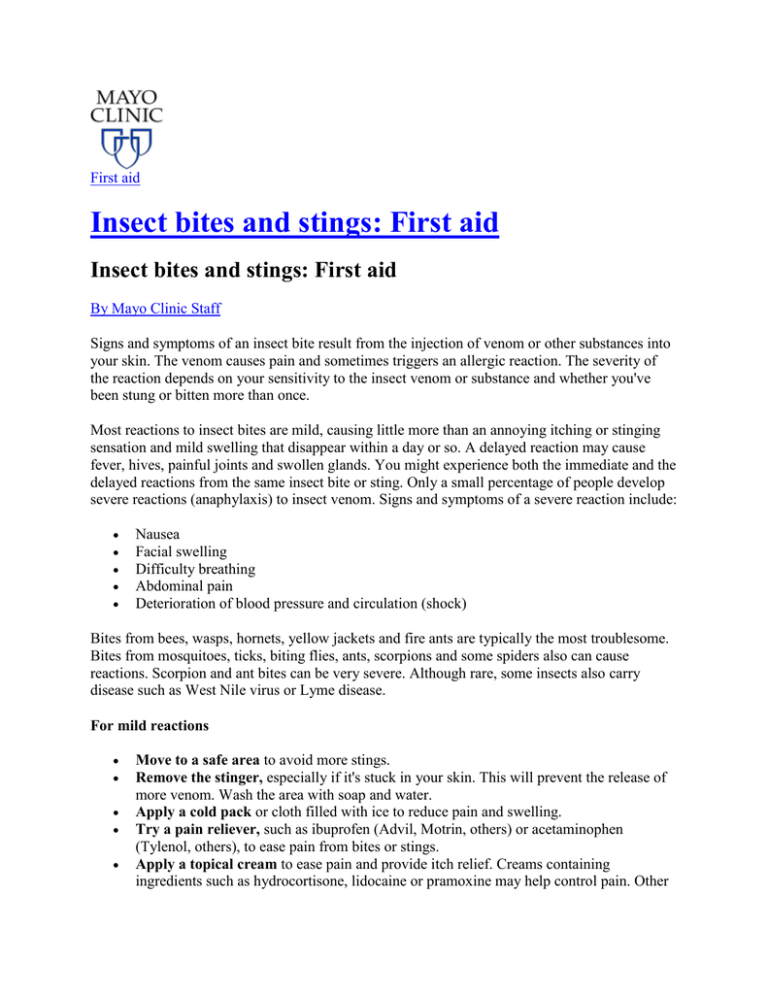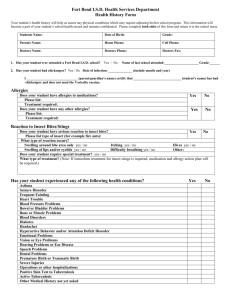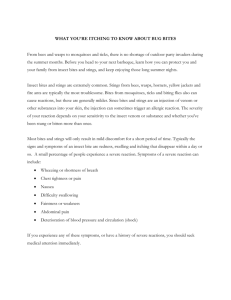
First aid
Insect bites and stings: First aid
Insect bites and stings: First aid
By Mayo Clinic Staff
Signs and symptoms of an insect bite result from the injection of venom or other substances into
your skin. The venom causes pain and sometimes triggers an allergic reaction. The severity of
the reaction depends on your sensitivity to the insect venom or substance and whether you've
been stung or bitten more than once.
Most reactions to insect bites are mild, causing little more than an annoying itching or stinging
sensation and mild swelling that disappear within a day or so. A delayed reaction may cause
fever, hives, painful joints and swollen glands. You might experience both the immediate and the
delayed reactions from the same insect bite or sting. Only a small percentage of people develop
severe reactions (anaphylaxis) to insect venom. Signs and symptoms of a severe reaction include:
Nausea
Facial swelling
Difficulty breathing
Abdominal pain
Deterioration of blood pressure and circulation (shock)
Bites from bees, wasps, hornets, yellow jackets and fire ants are typically the most troublesome.
Bites from mosquitoes, ticks, biting flies, ants, scorpions and some spiders also can cause
reactions. Scorpion and ant bites can be very severe. Although rare, some insects also carry
disease such as West Nile virus or Lyme disease.
For mild reactions
Move to a safe area to avoid more stings.
Remove the stinger, especially if it's stuck in your skin. This will prevent the release of
more venom. Wash the area with soap and water.
Apply a cold pack or cloth filled with ice to reduce pain and swelling.
Try a pain reliever, such as ibuprofen (Advil, Motrin, others) or acetaminophen
(Tylenol, others), to ease pain from bites or stings.
Apply a topical cream to ease pain and provide itch relief. Creams containing
ingredients such as hydrocortisone, lidocaine or pramoxine may help control pain. Other
creams, such as calamine lotion or those containing colloidal oatmeal or baking soda, can
help soothe itchy skin.
Take an antihistamine containing diphenhydramine (Benadryl, others) or
chlorpheniramine maleate (Chlor-Trimeton, others).
Allergic reactions may include mild nausea and intestinal cramps, diarrhea, or swelling larger
than 4 inches (about 10 centimeters) in diameter at the site, bigger than the size of a baseball. See
your doctor promptly if you experience any of these signs and symptoms.
For severe reactions
Severe reactions affect more than just the site of the insect bite and may progress rapidly. Call
911 or emergency medical assistance if the following signs or symptoms occur:
Difficulty breathing
Swelling of the lips or throat
Faintness
Dizziness
Confusion
Rapid heartbeat
Hives
Nausea, cramps and vomiting
Take these actions immediately while waiting with an affected person for medical help:
1. Check for medications that the person might be carrying to treat an allergic attack, such
as an autoinjector of epinephrine (EpiPen, Twinject). Administer the drug as directed —
usually by pressing the autoinjector against the person's thigh and holding it in place for
several seconds. Massage the injection site for 10 seconds to enhance absorption.
2. Loosen tight clothing and cover the person with a blanket. Don't give anything to drink.
3. Turn the person on his or her side to prevent choking if there's vomiting or bleeding
from the mouth.
4. Begin CPR if there are no signs of circulation, such as breathing, coughing or movement.
If your doctor has prescribed an autoinjector of epinephrine, read the instructions before a
problem develops and also have your household members read them.
References
1. Stinging insect allergy: Tips to remember. American Academy of Allergy, Asthma &
Immunology. http://www.aaaai.org/conditions-and-treatments/library/allergylibrary/stinging-insect-allergy.aspx. Accessed Nov. 13, 2011.
2. Demain JG, et al. Anaphylaxis and insect allergy. Current Opinion in Allergy and
Clinical Immunology. 2010;10:318.
3. Insect bites and stings. American Academy of Pediatrics.
http://www.healthychildren.org/English/health-issues/conditions/skin/pages/Insect-Bitesand-Stings.aspx?nfstatus=401&nftoken=00000000-0000-0000-0000-
4.
5.
6.
7.
8.
000000000000&nfstatusdescription=ERROR%3a+No+local+token. Accessed Nov. 13,
2011.
Insect stings. The Merck Manuals: The Merck Manual for Healthcare Professionals.
http://www.merckmanuals.com/professional/injuries_poisoning/bites_and_stings/insect_s
tings.html. Accessed Nov. 13, 2011.
Beware of bug bites and stings. U.S. Food and Drug Administration.
http://www.fda.gov/ForConsumers/ConsumerUpdates/ucm048022.htm. Accessed Nov.
13, 2011.
Schneir AB, et al. Bites and Stings. In: Tintinalli JE, et al. Tintinalli's Emergency
Medicine: A Comprehensive Study Guide. 7th ed. New York, N.Y.: The McGraw-Hill
Companies; 2011. http://www.accessmedicine.com/content.aspx?aID=6379117.
Accessed November 21, 2011.
Rueff F, et al. Management of occupational Hymenoptera allergy. Current Opinion in
Allergy and Clinical Immunology. 2011;11:69.
Subbarao I, et al. American Medical Association Handbook of First Aid and Emergency
Care. New York, N.Y.: Random House; 2009:56.
Mar. 01, 2012
Original article: http://www.mayoclinic.org/first-aid/first-aid-insect-bites/basics/art-20056593
.
Mayo Clinic Footer
Legal Conditions and Terms
Any use of this site constitutes your agreement to the Terms and Conditions and Privacy Policy
linked below.
Terms and Conditions
Privacy Policy
Notice of Privacy Practices
Advertising
Mayo Clinic is a not-for-profit organization and proceeds from Web advertising help support our
mission. Mayo Clinic does not endorse any of the third party products and services advertised.
Advertising and sponsorship policy
Advertising and sponsorship opportunities
Reprint Permissions
A single copy of these materials may be reprinted for noncommercial personal use only. "Mayo,"
"Mayo Clinic," "MayoClinic.com," "EmbodyHealth," "Enhance your life," and the triple-shield
Mayo Clinic logo are trademarks of Mayo Foundation for Medical Education and Research.
© 1998-2014 Mayo Foundation for Medical Education and Research. All rights reserved.






